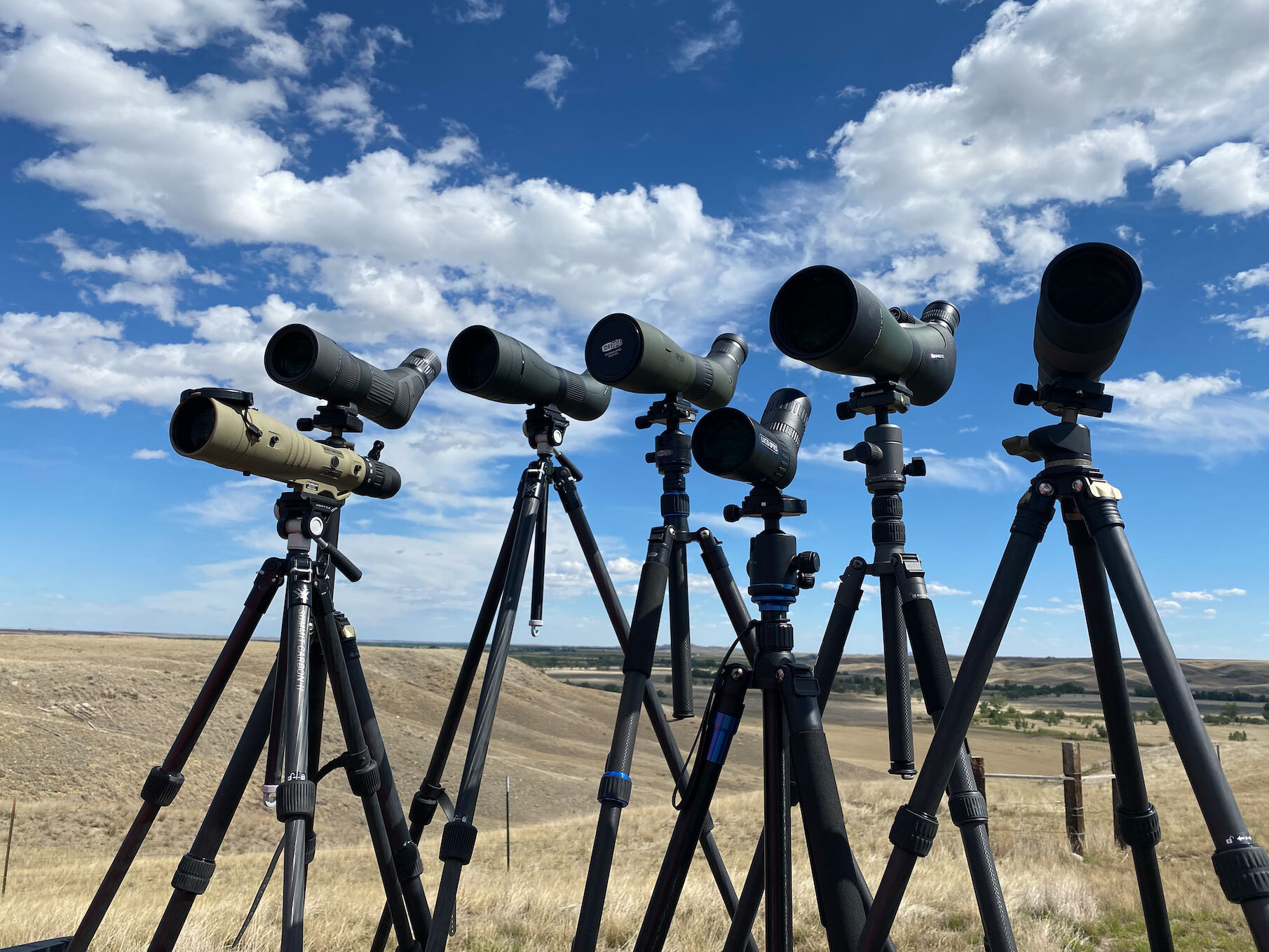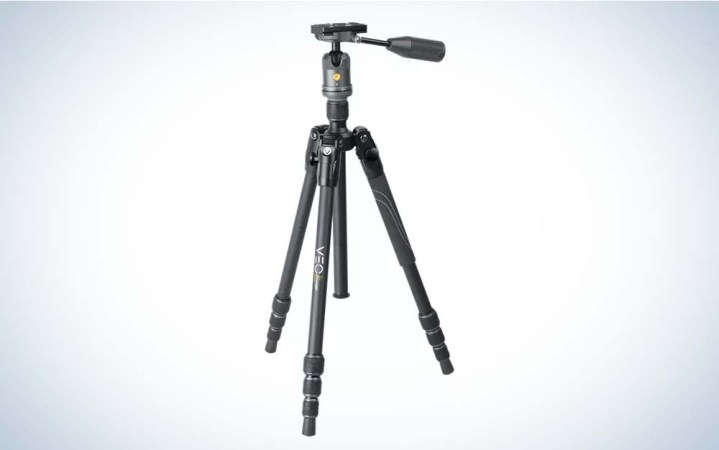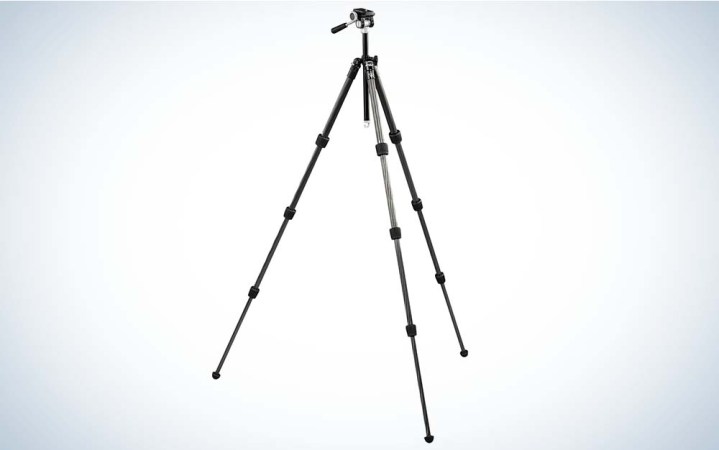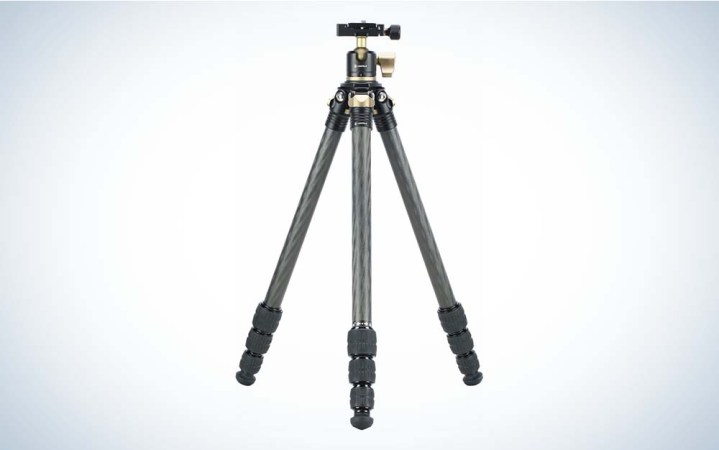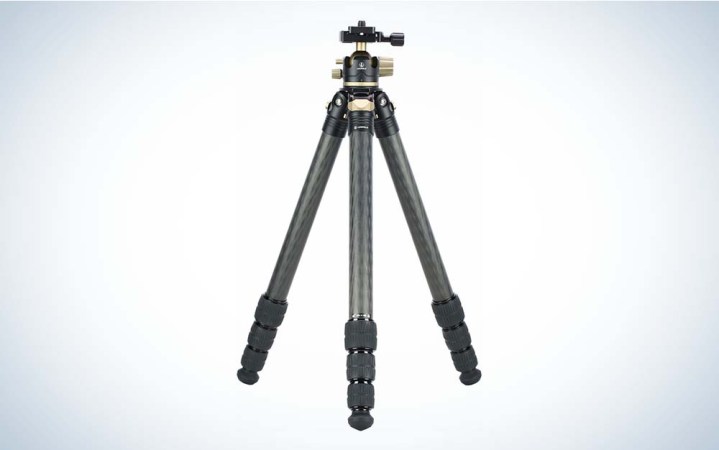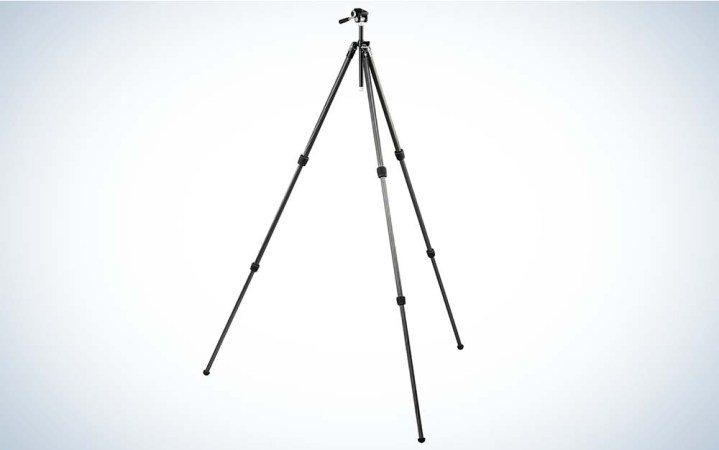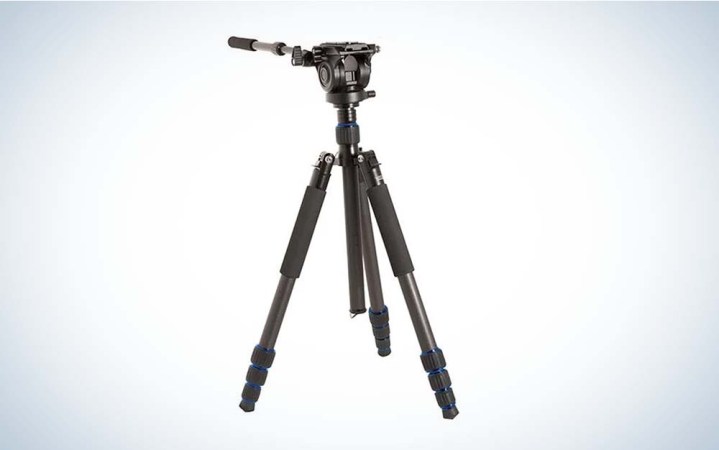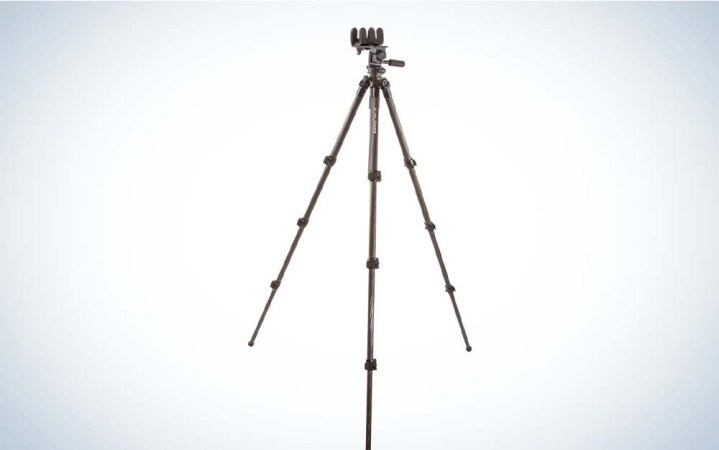We may earn revenue from the products available on this page and participate in affiliate programs. Learn More ›
In all the years that Outdoor Life has fielded its annual optics test, we’ve never considered the infrastructure that many optics depend upon: the tripods that stabilize the spotting scopes, riflescopes, and binoculars we evaluate.
The reason we haven’t focused on tripods is that it’s been a declining sector of the optics industry ever since they added that third leg to shooting sticks. There just aren’t that many ways to improve on the design that’s pretty much been static since the days of Galileo. But the tripod field has innovated this year, as carbon fiber has become more available and affordable. Mounting hardware has become both more technical and interchangeable, and backcountry hunters have insisted on lighter, stronger, and more versatile tripods. The result is a quantum leap in new tripod models that cover the waterfront in terms of price, performance, and portability.
We invited six brands to contribute eight new models to our optics test. We used them to stabilize spotting scopes, support our rail-mounted riflescopes, and give our laser rangefinders the rock-solid footing they require to deliver their best results. Unlike the optics, we didn’t rigorously test tripods. We confirmed their weight and dimensions by measuring their attributes with calipers and digital scales. We evaluated their capabilities against each other and against the expectations of each class — whether compact, ultralight carbon tripods, or full-size models capable of supporting the largest field optics and camera gear.
The models in our buyers’ guide include 2-pound bantams that are purpose built to pack into steep, remote country and help hunters glass distant animals. There are battle-hardened models that are designed to enable rifle shooters to make any shot in any position. And there are others that split the difference, delivering versatility and high strength-to-weight ratios.
How to Pick the Best Tripod for a Spotting Scope or Binoculars
Elements to consider if you’re in the market for a tripod: quality of the build, meaning not only the look and feel of the material, but also how tight the tolerances of moving parts; the versatility of the head; the strength-to-weight ratio of its legs; and the overall dimensions. If you intend to pack fast and light, maybe that latter consideration takes precedence. But if you intend to do a ton of glassing from a central lookout, then maybe you put more priority on a smooth and easy-to-operate head.
In the spirit of a buyers’ guide, we divided these eight tripods into three categories: ultralight compact models, lightweight full-sized models, and everything else. If you’re in the market for a new tripod, we hope you start your search here.
Best Lightweight Compact Tripods
This trio of tripods is purpose-built for the backcountry. They are light, compact, and have components that can be removed or added to configure for specific uses. If you’re in the market for a full-service tripod that weighs under 3 pounds, consider these.
Vanguard VEO 3 GO
This trim and ultracompact Vanguard tripod features five leg extensions, telescoping the pack height from 23.5 inches to a whopping 65.5 inches. Much of that height is achieved by extending the two-section center post out to 18 inches, but the whole unit weights just 3 pounds, 1 ounce, and has a weight rating of about 19 pounds.
The carbon fiber is finished nicely, and the ball head is compatible with Arca-Swiss mounting systems. We liked the oversized controls that have grippy rubber grab points. Other amenities include a detachable leg that can be transformed into a 67-inch monopod or even a selfie stick with the addition of the Bluetooth remote camera trigger. The Vanguard also comes with a mobile phone mount, spiked feet that can replace the rubber shoes. And its legs can be extended to create long-angle, low-profile stances that are extremely stable, even in ripping winds.
The price of this versatile tripod is also extremely appealing (it’s one of the best hunting tripods for the money), considering all the jobs it can do. MSRP: $199
Vortex Summit Carbon II
Weighing just 2.5 pounds, this new Vortex tripod combines a universal Arca-Swiss mounting plate with a two-way pan head that makes smooth horizontal and vertical adjustments a cinch. As with most of the Arca-Swiss mounting systems, the Vortex features a quick-release plate with ¼-20-pitch threads and a tension screw to cinch the plated optic to the head.
The four-section carbon fiber legs extend from 18 inches to just over 53 inches, and the quarter-turn twist-lock controls are some of the best in the class. Some of the Summit Carbon II’s height is achieved with the 7.5-inch removeable aluminum center post that has a J-hook to attach counterweights.
You’ll probably need that additional weight in windy conditions, because the Summit Carbon II doesn’t have much heft on its own. Vortex claims it’s strength rated to 22 pounds, and while we didn’t test that limit, it’s not quite robust enough to stabilize the heaviest spotting scopes or rifles. The bottom leg sections are only 5/16-inch in diameter, shaving weight but giving the tripod a spindly look and feel. On a per-pound basis, this is easily the most expensive tripod in our collection.
Still, this is the tripod that we reached for before others in this group for a backcountry hunt (this just might be the best glassing and shooting tripod for elk hunting). It’s strong, simple, versatile, and so light you’ll hardly remember you’re packing it. MSRP: $549
Leupold Alpine CF-425
A true alpine tripod, this was the lightest model in our evaluation, and also one of the most enjoyable to deploy, thanks to extremely positive controls and precise adjustments. Some of the elements are just a little too small; I misplaced the half-scale mounting plate, for instance, but was able to use standard Arca-Swiss plates from another unit.
The tripod is built around its four-leg carbon fiber struts, which descend in diameter from 11/16-inch to wee 5/16-inch. The legs lock with positive quarter-turn twist-lock controls that have oversized rubber grips that make deployment even with heavy gloves. The micro ball head is smooth and pans nicely.
The packed length of the Leupold Alpine is 18.5 inches, but it extends to 58.5 inches. A removeable center post adds just over a foot of length to this total, and it’s worth noting that unlike other center posts, which nest in the vacancy between the legs, the Leupold post screws into the top of the tripod. That makes it removeable, which is a nice feature in case you simply don’t need to pack it, but because it stores off the tripod, it’s easy to lose or to forget, costing the Alpine significant height.
The Leupold ships with a set of metal spikes that can replace the rubber feet and give the tripod excellent purchase in sandy or loose soil. The unit has a J-hook to accept counterweights, and the legs pivot out to allow the unit to lower to just 5 inches, giving it plenty of stability in high winds.
Given that the performance of the Leupold Alpine is on par with the Vortex Summit Carbon II, but costs just half as much, we gave the Leupold extra price/value points. MSRP: $249
Best Full-Size Carbon Tripods
The three tripods in this collection are heavier than their ultra-compact brethren (two are literally big brothers from the same brands), but offer more weight-bearing capability and better durability. Their carbon-fiber construction makes them about half the weight of similar configurations made of aluminum, but also significantly more expensive.
Leupold Pro Guide CF-436
Built on four-section carbon legs that extend from 22 inches to a whopping 67 inches (that’s 5 feet 5 inches), this is a full-sized tripod that is capable of stabilizing the largest spotting scopes and camera lenses. As we noted with its little brother, Leupold’s Alpine, the Pro Guide has a similar removeable center post that adds about a foot to is overall height. And as with the Alpine, I have the same pro-and-con consideration of the post: it’s great as an elective component, but it’s also easy to lose or forget to pack.
Without the 5-ounce center post, the Pro Guide’s pack weight dips under the 4-pound mark, making it the second-lightest of the big carbon tripods in our collection.
The legs deploy with precision and ease, thanks to the quarter-turn twist-lock controls that have oversized rubber grips. The carbon is smooth and strong, and the ball head and Arca-Swiss mounting hardware is fluid and versatile. Just as with the Alpine, this tripod ships with a set of steel feet that can replace the rubber shoes that are attached out of the box.
The Pro Guide handles like a tripod twice its weight and with more durable construction. The carbon legs are part of the reason. The uppermost section is 1-1/16 inch in diameter, and each smaller section diminishes to 7/8 inch, ¾ inch, and finally, ½ inch for the smallest leg section. That’s not quite twice as bulky as the carbon legs of the ultralight tripods, and the strength they provide the Pro Guide more than compensate for the small amount more weight they add to the package.
But they do add weight, and for those hunters who are counting ounces, this might not be the tripod for a backcountry adventure. However that weight and the performance of this model make it one of the best hunting tripods for glassing. For almost every front-country outing, especially those that require big lenses, this is an excellent choice, and we found that its price was fair for the capability it delivers. MSRP: $399
Vortex Ridgeview Carbon
I was so impressed with this big, brawny carbon fiber tripod that I took it to Alaska for a fly-in DIY caribou hunt, an expedition that put a premium on convertible gear. True to form, the Ridgeview served as my optics tripod, and it also doubled as an essential shooting tool, stabilizing my rifle in muskeg that was far too tall and bushy for a normal bipod. I shot a trophy bull with this tripod as my base.
I also used the Ridgeview as the stand for a windsock made of a garbage bag to help land the plane that picked us up at the end of our hunt. Versatile, indeed.
This is a longer tripod than others in this category, largely because it has three leg sections, rather than four. Each leg is about 22 inches long, which helps explain why its packed length of 29 inches is relatively long. It telescopes out to a whopping 75 inches (6 feet, 2 inches), though you’ll be hard pressed to find a hunter who requires all that extension.
The legs are made of carbon fiber, but the 10-inch center post is made of aluminum. The controls are delightful — quarter-turn twist-lock knurls made of grippy rubber — so they’re a cinch to use with gloves. The two-way pan head with Arca-Swiss compatibility is simple and versatile, and the standard tension quick-release plate works with a wide variety of brands and plate styles. It’s worth noting the ease of use with the pan head, which is controlled by a tension handle that allows users to make velvet-smooth pans, then lock the head with an economy of motion and fuss.
The weight of this Vortex tripod is pleasing, tipping the scale at 3 pounds, 2 ounces. Vortex claims a weight capacity of 22 pounds, and because it handled all my full-size spotting scopes and 8-pound rifle with aplomb, I have no problem believing that.
Still, this is a long dog. That’s not a problem for most expeditions, but if your kit must fit in a 30-inch duffle, then you’ll make it with this tripod, but barely. We thought the price was in line with the performance of this rugged, reliable carbon workhorse. MSRP: $499
Meopta Carbon Fiber Tripod
Possibly the bargain of the category, this carbon fiber tripod can do just about anything its steel or aluminum brethren can do, but at the same price and at half the weight.
Meopta’s Carbon Fiber has four leg sections, ships with two heads and plates — plus, a whole collection of accessories — and is stout enough to handle just about any jobs. We mounted an 85mm spotting scope on this and didn’t detect any unexpected vibration or shake.
The Meopta model extends from 25 inches to 66.5 inches, and a full foot of that extension is a carbon fiber center post. The controls are standard twist-lock operation, and the leg diameters are all in what I’d call the moderate diameters, ranging from 7/8 inch, to ¾ inch, then 5/8 inch, and the last leg section is ½ inch diameter. The unit weighs 4 pounds, 3.7 ounces.
One of the legs can unscrew from the base to be used as a monopod that accepts the center post and all heads. If you’re looking for a do-all tripod kit, this is hard to beat. It ships with a deluxe ball head, a very nice fluid head, two full-sized plates, plus a mobile-phone mount, a metal foot replacement kit, and a nice vinyl carry case.
All that capability and amenities for such an accessible price must have a catch, and if we found one: it’s in the quality of the components. The carbon fiber seems slightly less robust than those of its peers, and the twist-lock connectors aren’t quite as positive. Still, for $300, there’s a ton of value and performance in this excellent and lightweight tripod. MSRP: $299
More Top Tripods for Hunting
We created this catch-all category for tripods that don’t really fit the light-and-trim or the full-body carbon categories. The two tripods here are noteworthy not only because they’re relatively new to the market, but also because they offer performance that’s not considered by the other categories.
Lucid Optics TC-4
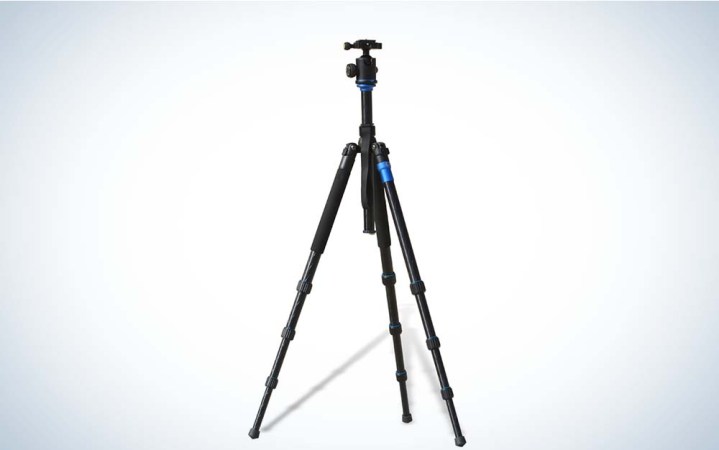
This is a fairly standard aluminum tripod from a relatively new brand, but if it’s a standard configuration, then it’s done well.
The TP4 has four textured leg sections that vary in diameter from 11/16 to 7/16 inches. At 3 pounds, 4.5 ounces, it’s a very lightweight aluminum model, and the twist-lock controls (with snazzy ice-blue accents) are positive and tight. The head is a Arca-Swiss design with a tension plate that accepts most optics.
The tripod packs down to 23 inches and expands to 63 inches, and one leg can unscrew to make a monopod that accepts the ball head.
Overall, it’s a relatively standard design, but it’s comforting to see it rendered well by a new brand on the landscape. MSRP: $229
Kopfjager K800CF with Reaper Grip
We evaluated two version of this tripod, which is designed by a German firm but distributed in the U.S. by Sellmark, the same brand that distributes Sightmark optics and Pulsar thermals.
By far the most interesting of the two models is the K800CF, a carbon fiber model that offers amazing strength and versatility without adding excessive weight. We also evaluated an aluminum version of the platform, the K700 AMT, which adds a bit of weight and strength, but not a ton of additional capability for just $100 less. For that reason, we’ll stick with the carbon fiber version here, but know that any description can just as easily apply to the aluminum model.
I first became acquainted with both the brand and the performance in the Texas hog fields, where hunters deploy rifles with thermal scopes during all-night hunting forays. Most hunters have this tripod, but what makes it essential for this work is the “Reaper” head, rubberized fingers that squeeze a rifle, making a rock-solid shooting platform no matter the vegetation or terrain.
The K800CF version has four carbon fiber leg sections that range in diameter from 7/8 inch down to ½ inch. The two-section aluminum center post adds another foot of extension. Leg sections are controlled by torsion-adjustable clip locks. The base tripod weighs 3 pounds, 13 ounces without the head. The Reaper head is a beefy number, and adds 2 pounds, 8 ounces to the total. But for the dead-stable rest it provides not only to rifles but to spotting scopes and cameras, those are easy pounds to give up. It’s worth noting that the aluminum version weighs 5 pounds, 10 ounces without the head.
Both tripods pack down to 24 inches and extends to 67.5 inches. The carbon version will hold 20 pounds; the aluminum version will hold 25 pounds of weight. Both are capable of handling the largest sports optics with ease.
The Reaper head is worth an entry to itself. It’s a marvel of adjustability, with the whole platform capable of panning thanks to a tension arm that locks to dead stable. The rubberized gun hand screws down to accept rifles with various forearms and designs. I’ve used mine to stabilize ARs and bolt guns, and even a lever gun. One of the best aspects is its cantilevered design that allows hunters to swap out magazines in ARs while keeping their rifles mounted in the rest. This feature makes it one of the best shooting tripods for coyote hunting or hog hunting.
The price is not alarming for the capability of both the tripod and the head, but even if you decide to go with a different tripod, you might consider investing in the Reaper head as an essential shooting aid for just about any hunting situation. MSRP: $599
FAQs
We answer your trio of questions on tripods.
Yes. The plate that comes with any of these tripods comes with a screw that is universal to any major spotting scope brand on the market. They will also pair with most DSLR cameras.
For a hunting tripod, the best material is carbon fiber. It’s super light, which is important for long hikes into the backcountry.
No, at least they are not good for hunting purposes. Cheap tripods are usually heavy or unstable. This means you’re going to have a shaky image while you’re trying to glass distant animals. Plus, you’ll be mounting an expensive optic to the tripod. Using a cheap tripod only limits the usefulness of your spotting scope or binocular.
